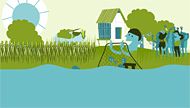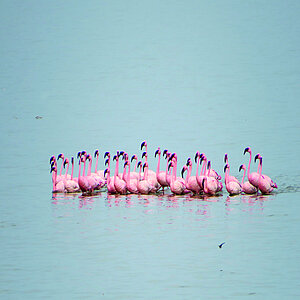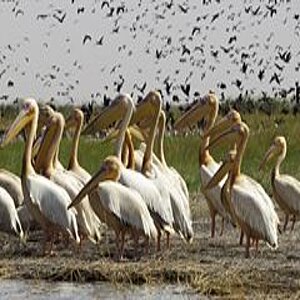Climate-resilient site network in the African-Eurasian flyway
For migratory birds, intact wetlands are key ecosystems without which they cannot successfully complete their annual migrations. This project is therefore working with partners to develop a contiguous network of wetland habitats. The focal point of this project was formed by key international habitats along the African-Eurasian Flyway. Apart from working to conserve ecosystems used by species of waterfowl, the project was also addressing improvements to the climate resilience of local communities. Project work was supporting the implementation of relevant provisions in the Agreement on the Conservation of African-Eurasian Migratory Waterbirds (AEWA). To achieve targeted improvements to key frameworks and the practical implementation of existing resolutions, insights gained in the project were shared with relevant structures and co-signatories from AEWA as well as the Ramsar Convention and the CBD.
- Countries
- Ethiopia, Mali
- IKI funding
- 3,189,728.50 €
- Duration
- 10/2015 till 12/2021
- Status
- completed
- Implementing organisation
- Wetlands International (WI) - Netherlands*
- Political Partner
-
- Ethiopian Wildlife Conservation Authority - Ethiopia
- Ministry of the Environment, Sanitation and Sustainable Development - Mali
- Implementing Partner
-
- Universität Kassel - Germany
- BirdLife International - Global Office - United Kingdom
- Ethiopian Wildlife and Natural History Society (EWNHS) - Ethiopia
- Horn of Africa Environmental Centre and Network (HoA-REC&N) - Ethiopia
- McGill University - Canada
- Ministry of the Environment, Sanitation and Sustainable Development - Mali
- Rift Valley Lakes Basin Authority - Ethiopia
- Rubicon Foundation - USA
State of implementation/results
- Project completed.
- An updated Critical Site Network (CSN) Tool was launched in December 2018 at the 14th meeting of the African Eurasian Waterbird Agreement Parties in Durban (South Africa). The CSN Tool (criticalsites.wetlands.org/…) is a web-portal that presents information about wetland sites of critical importance for waterbirds and the impact of climate change on the water availability in these wetlands across Africa, Europe and West Asia. This is of interest to a wide range of users including national governments, international and local humanitarian and conservation groups as well as the business community.
- A manuscript titled "Climate change exposure of waterbird species in the African-Eurasian flyways" was successfully submitted for publication.
- A landscape approach to disaster risk reduction has been developed by Wetlands International together with CARE-NL. It includes the Climate Resilient Flyways (CRF) work in the Ziway-Shalla sub-basin, Ethiopia, as a case study. This approach shows how to integrate different sectors and interests, allowing wetland landscape climate change adaptation that is beneficial for biodiversity to play a more central role. The approach in this publication is built upon the experiences of the CRF project and will form a base for further guidelines development.
- At the national scale in Ethiopia, the project supported the Environment, Forest and Climate Change Commission to advocate for the importance of wetlands in policy. Currently, the Ramsar Convention Ratification Accession Concept is in preparation.
- In Mali, a new law regulating the management of fauna and their habitat has been adopted by parliament which recognizes wetlands and corridors for migration as national wildlife domains (Article 9) and provides for protection of regional and locally important wildlife refuges (Article 10), providing greater support to sustainable management of the Inner Niger Delta and other wetlands.
- As a direct result of conservation work under CRF, in 2020 three times more colonially nesting waterbirds were spotted.
Latest Update:
04/2025
Project relations
Legend:
The link has been copied to the clipboard









